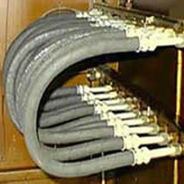Follow hydraulic hose best practices to improve runnability
Feb 16, 2016
The following are hydraulic hose best practices as part of increasing overall machine reliability. This is especially critical during roll removal and installation.
Best practices roll/hose binders
First, develop a dedicated "toolbox" for roll changes which includes a manual/binder containing the roll change procedures and laminated pictures of:
- The hoses properly routed, tagged and connected for operation
- The hoses disconnected and properly secured for roll removal
- Hydraulic unit schematics (in case of questions)
- Descriptions and part numbers of hoses, fittings and fitting seals
Have spare end caps for hoses and roll pipes available - in case of loss or damage.
Pre-pipe each roll exactly the same so fittings do not have to be transferred from the roll being removed to the roll going in. This saves time and reduces piping errors and leaks.
Permanently mark connections
Next, permanently mark each roll connection, each hose end and the pipe/tube where the hose connects with descriptive tags matching the hydraulic schematic descriptions. We also recommend stainless steel tags permanently attached to the roll and pipe/tube and secured to the disconnect end of the hose.
Hose disconnection steps
- Lock out and de-energize proper components.
- Clean each hose and connection area.
- Check to be sure all identifier tags are in place, correct and in good condition.
- Disconnect, clean and inspect: a. Hose fittings, roll fittings, seals and tags and replace if needed. b. Inspect hose for cracks, etc. and replace if needed. c. Do not use rags inside hoses or fittings.
- Route the disconnected hose and secure it in place so it does not get damaged or fall/swing down accidentally during maintenance.
- Take pictures of the best practices, and put them into the above-mentioned binder.
Hose reconnection steps
- Inspect each fitting to insure that the seals are in place and the fitting is clean.
- Reconnect each hose, double-checking tags.
- Double-check that the quick disconnect or fitting is properly engaged/connected. Many times if the fitting is not properly connected, flow can be restricted or completely cut off causing operational or equipment/roll damage.
- Start up and inspect for leaks.



Hose routing recommendations
The following hose routing recommendations and photo are courtesy of Parker:

- Do not bend the hose in an arc tighter than its minimum bend radius.
- When exiting the fitting, keep the hose straight for a distance equal to least 2x the width of the hose's inside diameter. (see photo)
- Always "double wrench" during installation while using the lay line to inspect for hose twist.
- Limit hose bends to a single plane. (see photo)
- Clamp hoses to prevent abrasion.
- Make installations neat and accessible for future maintenance.
Parker and other sources have excellent web articles on best practices for hose installation and routing. Topics including proper hose length and installation, proper bend radius, avoiding hose twist, routing and clamping are covered.
SAE International has published article SAE J1273 consisting of recommended practices for hydraulic hose assemblies which can be found at www.sae.org. The document covers hose selection and routing, hose / assembly fabrication, hose installation and replacement, hose storage and maintenance inspection. Similarly, ISO 17165-2 is an article listing practices to follow for hydraulic hose assemblies, and can be found at www.iso.org.
If you have any questions or need schematics, part numbers or other help building your Hydraulic Hose Best Practices procedures, contact your Valmet representative.